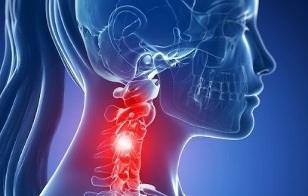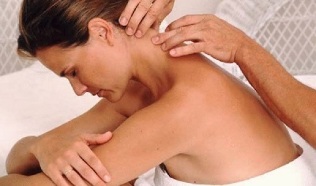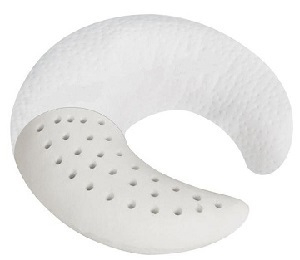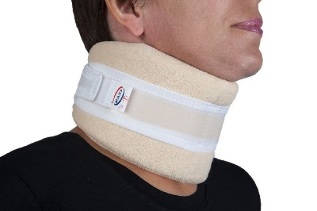
Osteochondrosis is a degenerative dystrophic intervertebral disc disease. The cervical area is the most vulnerable part of the spine. Its anatomical structure is different. The adjacent vertebrae are very tight and the muscle waist is weak. Therefore, even if the additional load on the neck is small, displacement of the vertebrae will occur, resulting in compression of blood vessels and nerves.
Also, because the vertebral artery that supplies blood to the brain passes through the hole in the transverse process of the vertebrae, pinching the vertebrae or squeezing the hole by overgrown osteophytes in this section can cause very serious consequences.
What is this?
Cervical osteochondrosis is a multi-pathogenic disease, manifested by intervertebral disc degeneration and spinal ligament dystrophy.
The reasonThe main reason and premise for the occurrence of cervical osteochondrosis is:
- Spine curvature, scoliosis
- Stress and nerve tension can have a negative impact on the general condition of the body and may cause cervical osteochondrosis.
- Past infectious diseases often become the root cause.
- Incorrect posture and discomfort during sleep (for example, uncomfortable pillow).
- Presence of congenital problems or hereditary diseases of the cervical spine.
- Poor posture in young people and adolescence
- Overweight, varying degrees of obesity. The extra pounds will increase the load on the vertebrae and intervertebral discs, leading to the degeneration process.
- A back injury may have occurred in childhood or adolescence.
- Disrupt the metabolic process
- Works related to physical labor may cause diseases in various parts of the spine.
- Inactive lifestyle, sedentary work, inappropriate exercise
In order to successfully treat cervical osteochondrosis, we must first determine the cause, promote its development and eliminate them. Until recently, the disease only occurred in people over 45 years of age. Now young people are exposed to it, the age range is 18-25 years old.
Cervical spine features
Let us consider how the cervical spine is different from other spine, and the prerequisite for the development of these syndromes during the development of osteochondrosis.
- is an important ganglion (node) of the autonomic nervous system in the neck area.
- In the lateral process of the vertebrae, there is a hole forming a canal through which the vertebral artery passes to provide oxygen and nutrients to the brain, cerebellum, hearing organs and spinal nerves. These are the prerequisites for frequent clamping of arteries and nerves.
- The cervical spine has the highest mobility. His characteristic is that all types of movements are adequate. These are the prerequisites for frequent infringement and subluxation.
- The foramina of the lower three vertebrae is not round, but triangular. These are the prerequisites for the growth of bones formed in osteochondrosis to compress nerve roots.
- The disc is not located between the vertebral bodies over its entire length. In the front part, instead of them, there are protruding edges of the vertebrae, which are connected by joints. These are the prerequisites for the occurrence of joint subluxation.
Development phase
The degree of osteochondrosis depends on the clinical situation and the main complaint of the patient. The concept of degree should not be confused with the stage of osteochondrosis. These stages will be discussed below.
- First level degree. Clinical manifestations are very rare, and patients may complain of low-intensity pain in the cervical spine, which may aggravate the pain when turning their heads. Physical examination may show slight muscle tone in the neck.
- Second degree. The patient is worried about the pain of the cervical spine, which is more intense and may irradiate the shoulders and arms. This is caused by the reduction in the height of the intervertebral disc and the contraction of the nerve root. The pain will increase when tilting and turning the head. The patient may notice a decrease in performance, weakness, and headaches
- The third degree. The symptoms of cervical osteochondrosis intensify, and the pain becomes constant as the arm or shoulder is irradiated. When a herniated disc is formed, the muscles of the arm appear numb or weak. Worried about weakness and dizziness. Examination revealed limited cervical spine movement and pain on palpation.
- The fourth degree. The intervertebral disc is completely destroyed and replaced by connective tissue. Dizziness increases, tinnitus occurs, and coordination is impaired because the process involves the vertebral arteries that feed the cerebellum and the occipital lobes of the brain.
Symptoms
The severity of cervical osteochondrosis symptoms depends on the degree of destruction of the vertebral structure. The growth of bone tissue, the formation of osteophytes, nerve syndrome (clamping a nerve can cause neuralgia), and intervertebral hernia (a herniated disc entering the spinal canal) can exacerbate symptoms.
The first symptoms of the disease are recurring occipital headache, sore neck, cru twist and spine clicking when turning the head, and sometimes a slight shoulder tingling. Over time, the symptoms will increase and the intensity of the pain will increase.
Pain syndrome is the main manifestation of osteochondrosis. When turning the head, the neck pain will become dull, persistent or severe, and the back pain will be below the occiput. The entire cervical area or projection area of the modified vertebrae, as well as the clavicle, shoulder, shoulder bone, and heart area may be injured. Do not rule out pain radiation in the jaw, teeth, arms, ears, and eye areas. The muscles of the neck and shoulders are tense and painful when palpated. It is difficult to lift the arm from the side of the lesion-low back pain in the shoulder or neck. Head movement limitation due to pain usually occurs in the morning after sleeping in an uncomfortable posture.
The disease causes compression of peripheral nerve roots (nerve syndrome) and causes pain along these nerves.
It may be numbness of the hands or fingers, and the sensitivity of some nerve areas where nerves are compressed.Some characteristic symptoms indicate which vertebrae are affected:
- C1-The sensitivity of the occipital region is impaired;
- C2-Pain in the occipital and parietal area;
- C3-The sensitivity and pain of the half of the neck where the spinal cord has been invaded may be reduced. It may be that the sensitivity of the tongue is impaired. The loss of control of the tongue leads to speech impairment;
- C4-Impaired sensitivity and pain in the scapular region of the shoulders, decreased tone of the head and neck muscles, possible respiratory diseases, liver and heart pain;
- C5-Pain and sensory disturbance on the outer surface of the shoulder;
- C6-pain extends from neck to shoulder blade, forearm, outer surface of shoulder, radial surface of forearm to thumb;
- C7-Pain extends from the neck to the cap bone, the back of the shoulder, the forearm to the fingers II-IV of the hand, and the sensitivity of this area is impaired.
- C8-Pain and sensory disturbances spread from the neck to the shoulders, from the forearms to the little finger.
Neck osteochondrosis is always accompanied by headache. Turning the neck or moving suddenly can exacerbate severe persistent pain. Some patients complain of a heavy head. Compression of the vertebral artery can cause dizziness and nausea. There was a noise in my ears, and black spots flashed in front of my eyes. The deterioration of the cerebral circulation will cause a gradual decrease in hearing and visual acuity, numbness of the tongue and changes in taste.
Cervical osteochondrosis observed in every patient is almost always accompanied by rattling or creaking during neck movements. Crunch occurs when the head is turned sharply or thrown back.
Syndromes caused by cervical osteochondrosis
The symptoms of cervical osteochondrosis are divided into specific groups called syndromes. Their presence and severity may indicate cervical pathology with a designated location.
A set of common syndromes:
- Vegetable dystonia syndrome. Subluxation of the first cervical spine with displacement can lead to the development of vegetative vascular dystonia. VSD is not a definitive diagnosis because it has no obvious symptoms. There may be neurological symptoms, symptoms of impaired cerebral blood flow, surges in intracranial pressure, and muscle spasms. As a result, the patient's main complaints were reduced to dizziness, decreased vision, loss of consciousness, headache, and nausea.
- Irritation-reflexive. When the head and neck changes drastically, when sneezing and head turning sharply, there will be burning and severe pain in the back of the head and neck, sometimes returning to the chest and shoulders.
- root. It is also called cervical radiculitis, and it combines symptoms related to the invasion of cervical nerve roots. "Chills" appear in the affected area, fingers, forearms, and creamy skin become numb and spread to some fingers.
- Heart. Almost the same image as angina pectoris usually leads to incorrect diagnosis and treatment. The appearance of this syndrome is due to stimulation of phr nerve receptors, which partially affects the pericardium and pectoralis major muscle. Therefore, the spasm in the heart area is more reflexive, just like a response to cervical nerve stimulation.
- Vertebral artery syndrome. It is directly developed by the compression of the artery itself and the stimulation of the surrounding sympathetic nerve plexus. This pathological pain is burning or twitching in the occipital area, and spreads to the temples, upper ciliary arch and coronary. Occurs on one side and both sides simultaneously. The patient usually falls asleep in a non-physiological position, walks during transportation, and after walking, the condition worsens. When the symptoms are severe, hearing loss, dizziness, tinnitus, nausea, vomiting, loss of consciousness and increased blood pressure may occur.
Diagnostics
Like any medical diagnosis, the diagnosis of osteochondrosis is established based on the patient's chief complaint, medical history, clinical examination and auxiliary research methods. Radiography of the cervical spine is performed in frontal and lateral projections, if necessary in a special position (open mouth). At the same time, experts are interested in the height of the intervertebral disc and the presence of osteophytes.
In modern research methods, NMR and CT research are used to verify the diagnosis most accurately. In addition to the other research methods listed, you may need to consult relevant experts (cardiologists, ophthalmologists, neurosurgeons), and it is essential that a neurologist conducts an examination. The neurologist is engaged in the treatment of osteochondrosis. Therefore, after examining the patient, he will prescribe the necessary minimum examination methods based on his own judgment.
How to treat cervical osteochondrosis
The comprehensive treatment of cervical osteochondrosis may include the following traditional and non-traditional methods: medical treatment, massage, acupressure, artificial therapy, physical therapy, acupuncture, homeopathy, folk therapy, etc.
The main treatment plan for osteochondrosis is the same for all parts of the disease:
- First, you need to ease the pain.
- Then the swelling is relieved
- At this stage, blood circulation must be normalized.
- Muscle-strengthening corset
- Improve tissue nutrition and regeneration.
The list of drugs and medicines for treating cervical osteochondrosis at home is very extensive:
- Anti-inflammatory drugs (steroids). These are hormonal drugs that can relieve inflammation and thereby eliminate pain;
- Analgesics (non-steroidal drugs that relieve pain). They are usually prescribed as tablets or capsules. It should be remembered that most of these drugs will irritate the mucosa of the digestive tract;
- Muscle relaxants are drugs that relax muscle tension. They are used in surgical procedures and orthopedic operations to relieve pain. These drugs are administered parenterally, so they are always administered under medical supervision. There are a large number of contraindications;
- Chondroprotective agents are drugs that contain substances that replace cartilage tissue components. In order to obtain long-lasting positive effects, such drugs must be taken for a long time;
- topical ointments and gels. This is the most convenient medicine to use at home. They are divided into relieve inflammation, reduce temperature and relieve pain. Such funds are often advertised. For cervical osteochondrosis, not all ointments are effective. In addition, due to their availability, they are sometimes used unreasonably, and the specificity of the pathogenesis is not considered.
- Vitamins. For osteochondrosis, vitamins need to be prescribed, which have a beneficial effect on the peripheral nervous system and improve electrical conductivity. Water-soluble vitamins: B1, B6, B12, fat-soluble vitamins: A, C, D, E. In recent years, combination preparations containing analgesics and vitamins have become more common.

Only a group of excellent experts can choose the most suitable treatment method, including neurologists, physical therapists, massage therapists, surgeons, and vertebral neurologists.
Physiotherapy
Exercise therapy for acute osteoporosis should be performed outside the acute exacerbation period. The maximum efficiency of this technique is during the recovery period. There should be no discomfort and pain during the execution of the complex!
- Exercise #1. Lie on your stomach, put your hands on the floor, raise your head and torso, and your back should be straight. Stay in this position for 1-2 minutes. Slowly lower yourself to the floor. Repeat 2-3 times
- Exercise #2. Lie on your stomach, extend your arms, rotate your head to the left, touch the floor with your ears, and then rotate your head to the right. Repeat 6-7 times in each direction.
- Exercise #3. In a sitting position, when you inhale, bend forward and try to touch your chest with your head, then exhale, bend back and tilt your head back. Repeat 10-15 times.
- Exercise #4. When sitting, place your palms on your forehead, press firmly on your forehead, and place your forehead on your palm. Continue this exercise for 30 seconds. Repeat 2-3 times
- Exercise #5. First slowly rotate the head in one direction, and then slowly rotate in the other direction. 10 rotations in each direction. Pay attention to dizziness. When it appears, practice stops.
Massage therapy
You can perform massage at home, but be very careful not to aggravate and harm the patient. The patient should lie prone, put the forehead on the hand, and extend the chin to the chest. The neck muscles must be completely relaxed
- stroked. The massage must be started by the following actions: stroke the collar in the direction from the lymph to the supraclavicular and axillary lymph nodes. Then apply gentle strokes.
- Push-ups. To perform push-ups, the masseur places one hand on the neck (the index finger and thumb should be placed together) and moves the spine down. Push-ups can also make the edge of the palm all the way to the shoulder joint.

- Friction. Rubbing can heat the muscles, relax them and improve blood flow to the area. The massage should start from the bottom of the skull and use your fingers to perform circular and linear movements. You can also make the sawing motion with the palm parallel to the ribs.
- Knead. The neck should be rubbed in a circular motion.
- Vibration. The massage ends with beating and vibration, which is completed by shaking and percussion.
Massage is necessary to increase muscle tone and relieve pain. According to the stage of osteochondrosis, the massage technique is selected. However, when performing neck massage, experts use all classic massage techniques: rubbing, stroking, kneading, etc. If the patient has pain on only one side, the massage will start from the healthy part of the neck and then gradually move to the painful part of the collar.
Manual therapy
Manual therapy helps to cope with acute and chronic pain, and can also increase the range of motion and improve posture. The main method of manual treatment of cervical osteochondrosis:
- Relaxing massage and segmented massage. Used to heat muscles and relieve tension.
- Mobilize. Designed to restore the effects of joint function through traction
- operation. Urgently target the patient's pathological area. This process is accompanied by a characteristic rattle (the joint returns to its normal position).
The chiropractor should be proficient in these techniques. Otherwise, any error may cause injury.
Orthopedic pillow
Orthopedic sleeping pillow is an effective preventive tool. In many cases, when sleeping on an uncomfortable pillow, additional compression of the carotid arteries and nerve roots can exacerbate rickets. Orthopedic products can ensure that a person's horizontal position during sleep is uniform, thereby ensuring that sufficient blood is provided to the brain.
When choosing a pillow, the individual anatomical characteristics of the person should be considered and related to the volume and characteristics of the filling. The right choice of pillow can bring tangible benefits to patients with cervical osteochondrosis.
Physiotherapy
Physiotherapy procedures for cervical osteochondrosis:
- Electrophoresis. It should be used with an analgesic (anesthetic), which is injected under the skin by electrical pulses.
- Ultrasound. It has a beneficial effect on the metabolic process of cervical spine tissues, as the swelling is eliminated, the pain disappears.
- Magnetic therapy. A safe treatment method involves exposing damaged cells to a low-frequency magnetic field. It has analgesic effect and can be used as an anti-inflammatory drug.
- Laser therapy. Improve blood circulation in the affected area, relieve tissue swelling and pain.
Physiotherapy has a beneficial effect on the intervertebral discs and vertebrae in cervical osteochondrosis. Combined with drug treatment, comprehensive treatment can help eliminate the symptoms of the disease. This procedure is carried out in a specialized ward of a hospital or polyclinic. Before starting the course, you must consult a doctor to determine the duration and type of physical therapy. During the worsening period, it is strictly prohibited to pass.

Wind collar
Shants collar is a soft and comfortable device, fixed with Velcro on the back, used for cervical chondropathy. But not for treatment, but to temporarily relax and relieve fatigue. You cannot wear it without taking it off, otherwise the neck muscles will stop working and quickly shrink. If Shants' collar is selected correctly, the patient will feel comfortable and protected.
Select the collar strictly according to the size of the pharmacy or orthopedic store. Do it better in the store, because usually the people who work there know the characteristics of their business and products very well, which means they can help in every situation.
Folk remedies
If the pain caused by osteochondrosis of the spine becomes unbearable and irregular, you will agree to take any measures to stop this pain, where traditional complex treatments can be successfully supplemented by other methods.
- Stick to celery root (5 grams per 1 liter of boiling water) for 4 hours, drink one tablespoon before each meal;
- Honey compresses hot compress, for this you need 2 teaspoons. Honey and 1 piece of mummy. We heat the ingredients in a water bath, spread them on the cloth, and then apply them to the neck (ie, neck) at night;
- If acute pain occurs, the growth of horseradish in this country will help me. I just wash his leaves, pour them into boiling water, cool them a bit, apply them to the neck, then wrap them in a thin scarf, and spend the night-you can already work and live in the morning.
- We insist on putting the chamomile flowers in vegetable oil for two days, preheating to boiling (for 500 ml of oil, 30 grams of plants are needed), rub it to the painful part;
- Honey potato hot compress is also helpful. To this end, the rhizomes must be ground and mixed with honey in equal amounts, and applied to the sore neck at night. Use it regularly, at least once a week.
Prevention
As usual, proper prevention will help avoid cervical osteochondrosis, but, of course, all physical exercises should be used regularly, otherwise "regular" exercise will hardly benefit.
Still need to remember a simple rule:
- Eat more calcium and magnesium foods. These are fish, peas, beans, nuts, cheese, herbs, but it is best not to add sugar, flour, smoke, or spicy.
- I often engage in sports, especially swimming, water aerobics and gymnastics, so that the vertebrae stretch and flexibility are also suitable for the prevention of osteochondrosis. This can be done at home.
- When sitting for a long time, do at least a few special exercises a day.
- Choose a high-quality orthopedic mattress and pillow that fits your neck and support your head in the correct anatomical position during sleep (yes, your favorite giant feather pillow will not disappear due to spine problems! )
If you already have such a diagnosis, the patient should keep his spine, ie:
- Be extra careful when lifting and carrying heavy objects. It is best to go to the store twice instead of pulling heavy bags with both hands, which will greatly strain the neck and shoulder belts;
- Don’t get too cold, avoid air circulation and air conditioning from the air conditioner (some people like to cool down in hot weather and stand with their backs to the fan);
- When bending the trunk forward, remember osteochondrosis;
- Avoid local muscle overheating in a hot hot bath;
- Don’t forget to leave the monitor regularly, change your posture, don’t sit for hours or even days;
- Relax your neck by purchasing a Shants collar;
- If possible, take a steam bath if the state of the cardiovascular system allows.
In short, what I want to say is that a child who is prone to osteochondrosis (parents have osteochondrosis) and an adult who contract the disease in the course of their lives, they just have to take preventive measures to avoidIf you are disabled, you will not die on the operating table. After all, the operation is quite complicated and requires long-term rehabilitation. In addition, it is not always possible, because there are cases of inoperable, so it is best to protect your health from the effects of youth, as long as the intervertebral disc is intact and unnecessary growth does not compress blood vessels.






































